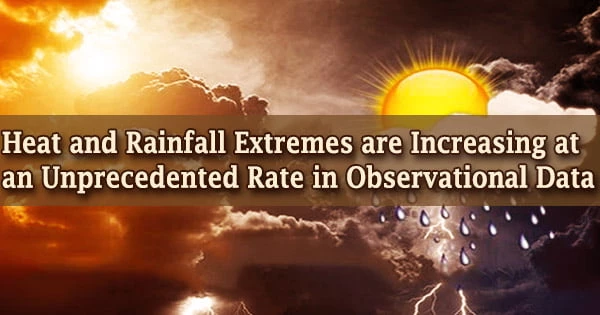Researchers evaluating the effects of the Montreal Protocol claim that without the global CFC ban, we would already be living in a “scorched earth” reality.
According to their new research, if humanity had continued to use ozone-depleting chemicals like CFCs, the planet’s vital capacity to absorb carbon from the atmosphere would have been severely compromised, raising global temperatures.
The “World Avoided,” which the worldwide team of scientists from the UK, USA, and New Zealand refer to as, portrays a devastating picture of a burnt planet Earth without the Montreal Protocol in new modeling that was published today in Nature. The ozone layer hole and global warming are two key environmental concerns that this study shows a new, clear connection between.
The research team, lead by a scientist from Lancaster University, finds that the ongoing and growing use of ozone-depleting chemicals, most notably CFCs, would have contributed to an additional 2.5°C rise in global air temperatures by the end of this century if their use had gone uncontrolled.
Their research shows that prohibiting CFCs has improved climate protection in two ways: it has reduced their greenhouse effect and, by preserving the ozone layer, has shielded plants from harmful increases in ultraviolet radiation (UV).
Their findings are summarized in the paper “The Montreal Protocol protects the terrestrial carbon sink”. The ability of plants to absorb and store carbon dioxide from the atmosphere has been crucially preserved, which has stopped the acceleration of climate change.
By combining data on ozone depletion, plant damage from increasing UV, the carbon cycle, and climate change, the study team created a novel modeling framework. Their cutting-edge simulations depict an alternative future on a planet where CFC use grew by about 3% annually.
With our research, we can see that the Montreal Protocol’s successes extend beyond protecting humanity from increased UV to protecting the ability of plants and trees to absorb CO2. Although we can hope that we never would have reached the catastrophic world as we simulated, it does remind us of the importance of continuing to protect the ozone layer. Entirely conceivable threats to it still exist, such as from unregulated use of CFCs.
Dr. Paul Young
Their modelling reveals:
- Continued growth in CFCs would have led to a worldwide collapse in the ozone layer by the 2040s.
- Ozone above the tropics would have been 60% less by the year 2100. The hole that emerged above the Antarctic would not have been as bad as the depletion above the tropics.
- By 2050, the mid-latitudes, which encompass most of Europe, the United Kingdom, the United States, and central Asia, would have greater UV radiation from the sun than the current tropics.
The depleted ozone layer would have seen the planet, and its vegetation, exposed to far more of the sun’s UV.
Through photosynthesis, plants absorb carbon dioxide (CO2), and research has shown that significant increases in UV can limit plant growth by harming their tissues and reducing their capacity for photosynthesis. This indicates that the plants take in less carbon.
In addition, with less carbon in plants, less carbon is trapped into soils, which is what happens to a lot of plant matter once it dies. This entire scenario would have taken place on a worldwide scale.
According to the researchers’ calculations, the quantity of carbon absorbed by plants, trees, and soils over the course of this century substantially decreases in a world without the Montreal Protocol. Less carbon is stored in soils and plants, which means more CO2 is released into the atmosphere.
Overall, by the end of this century without the Montreal Protocol CFC ban:
- There would have been 580 billion tonnes less carbon stored in forests, other vegetation, and soils.
- Depending on the scenario for future emissions from fossil fuels, there would be an increase in atmospheric CO2 of 165-215 parts per million. This is an additional 40–50% of CO2 compared to the 420 parts per million CO2 that we have today.
- Through its greenhouse effect, the enormous additional CO2 would have caused a further 0.8°C of warming.
Ozone-depleting compounds, including CFCs, are also potent greenhouse gases, and prior studies have indicated that their ban prevented their greenhouse effect-related contribution to global warming.
Their greenhouse impact alone would have added 1.7°C to global warming by the end of this century. In total, temperatures would have increased 2.5°C due to this additional CO2 produced as a result of the damaged vegetation in addition to the previously calculated warming of 0.8°C.
Dr. Paul Young, lead author from Lancaster University, said: “Our new modelling tools have allowed us to investigate the scorched Earth that could have resulted without the Montreal Protocol’s ban on ozone depleting substances.”
“A world where these chemicals increased and continued to strip away at our protective ozone layer would have been catastrophic for human health, but also for vegetation. The increased UV would have massively stunted the ability of plants to soak up carbon from the atmosphere, meaning higher CO2 levels and more global warming.”
“With our research, we can see that the Montreal Protocol’s successes extend beyond protecting humanity from increased UV to protecting the ability of plants and trees to absorb CO2. Although we can hope that we never would have reached the catastrophic world as we simulated, it does remind us of the importance of continuing to protect the ozone layer. Entirely conceivable threats to it still exist, such as from unregulated use of CFCs.”
The world has already warmed by 1°C compared to pre-industrial levels. Even if we were to achieve net zero CO2 emissions, the additional 2.5°C rise would bring the global temperature rise to 3.5°C.
The majority of experts believe that an increase in global temperatures of 1.5°C above pre-industrial levels is the maximum that can be achieved while still avoiding some of the worst effects of climate change.
Dr. Chris Huntingford of the UK Centre for Ecology & Hydrology said: “This analysis reveals a remarkable linkage, via the carbon cycle, between the two global environmental concerns of damage to the ozone layer and global warming.”
Background information
The ozone layer is a crucial barrier that shields humans from the sun’s dangerous UV rays. Due to the harm UV can do to human health through disorders like skin cancer, when a hole in the layer over Antarctica was identified in the 1980s, it raised serious concerns.
The 1987 Montreal Protocol is held up as a shining example of environmental diplomacy. International authorities were able to save the ozone layer by deciding to enact an international ban on ozone-depleting compounds, including CFCs. Because of the Montreal Protocol, the ozone layer is going through a protracted healing process.
Funders: The research was supported by the Engineering and Physical Science Research Council, Natural Environment Research Council, Lancaster University, the UK and New Zealand governments, NASA and the United States’ National Science Foundation.
In this study, researchers from Lancaster and Exeter Universities, the UK Centre for Ecology & Hydrology, NASA, the National Center for Atmospheric Research, and the National Institute for Water and Atmospheric Research collaborate with experts in atmospheric chemistry, physics, plant science, and land surface modeling.
















